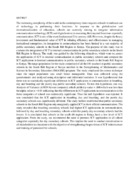| dc.description.abstract | The increasing complexity of the world in the contemporary times requires schools to embrace use of technology in performing their functions. In response to the globalization and internationalization of education, schools are earnestly striving to integrate information communication technology (ICT) and digitalization in executing their myriad functions especially communication. ICT is one of the most fundamental 21st century skill. However, despite the heavy investment and fundamental value of ICT in infusing efficiency and effectiveness in managing institutional enterprises, its integration in communication has been limited in a vast majority of public secondary schools in the South Rift Region in Kenya. The purpose of this study was to evaluate the integration of ICT in internal communication in public secondary schools in the South Rift Region in Kenya. The study was guided by the following objectives, which were to; assess the application of ICT in internal communication in public secondary schools and compare the ICT application in internal communication in public secondary schools in the South Rift Region in Kenya. The target population for the study comprised of all the 141 teachers in public secondary schools in the South Rift Region of Kenya enrolled in the Strengthening of Mathematics and Science in Secondary Education (SMASSE) program. The study employed the census technique since the target population was small hence manageable. Data was collected using the questionnaire and analyzed using descriptive and inferential statistics. It was hypothesized that there was no statistically significant difference in ICT application in communication in boarding, day and boarding and the purely day public secondary schools. To test this hypothesis, one way Analysis of Variance (ANOVA) was computed, which yielded p-value = .000 which was less than the alpha value α > 0.05 indicating that the differences in ICT application in communication in the three categories of school was statistically significant. Thus the null hypothesis was rejected. It was concluded that the ICT application in boarding, day and boarding, and the purely day secondary schools was significantly different. The study further established that public secondary schools in the South Rift Region only marginally applied ICT in their official communication. The study revealed that boarding secondary schools had higher ICT applications in communication, followed by day and boarding secondary schools while the purely day secondary schools had the lowest. It is concluded that schools in the south rift region in Kenya have a low level of ICT application. From the study, we recommend the need to promote ICT application in all school categories especially the day secondary schools. This implies the need to conduct sensitization to all stakeholders in education with the objective of strengthening the provision of ICT infrastructure and training of personnel for schools. | en_US |
